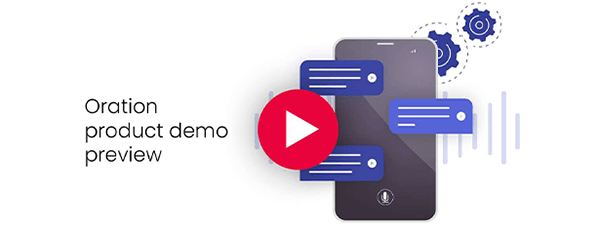To a modern digitally savvy customer, traditional DTMF IVR solutions can seem outdated and confusing to use. Trying to navigate your way to the best resolution following commands like “press one for this, and two for that”, often lands you in a place you don’t mean to be before you find yourself going right back to the start, or being redirected to another call queue by an agent. We’ve all been there.
An IVR solution that uses Natural Language Processing (NLP) however, can completely transform the customer experience on the phone, enabling customers to be directed to the most appropriate outcome straight away by asking them one simple open-ended question: “How can we help you today?” By understanding a customer’s immediate natural language response, the IVR system can quickly route customers to the right agent, or even direct them to a huge range of self-serve options that would be virtually impossible to implement through restrictive and convoluted numerical menu systems.
What does NLP look like in action?
Natural language processing is a form of artificial intelligence that enables software to understand spoken (or written) words and phrases in much the same way as humans can. Fortunately, NLP technology has come a long way since its early inception in products like Siri and Amazon Alexa around a decade ago – and even then, consumers had a huge appetite for the convenience and benefits it could bring. So, what is artificial intelligence natural language processing?
Today, NLP brings together the most advanced and sophisticated technologies such as machine learning to create a model of human language. Ultimately, this means that software can process conversational language to determine a caller’s intent, not just by recognising certain keywords and phrases, but by developing a deep understanding of how people casually use language around keywords to express their true intention and sentiment.
Let’s look at a scenario where a caller responds to an automated IVR greeting with “I’d like to find out more about product X on your website” – then compare this to a customer who says, “I’m having problems setting up product X”. While NLP technology will determine that product X is the subject matter of both calls, NLP can interpret the language used around the subject matter to direct the call to a sales agent in the first scenario, while directing the call to a customer service or technical support agent in the second scenario.
Another major benefit of IVR solutions with NLP capabilities is that they can accurately transcribe a customer’s initial verbal response to deliver useful verbatim to an agent’s screen before they pick up a call. In call centres that use DTMF menu options, agents will only know what option the customer has pressed, which means they often find themselves trying to elicit basic information about the nature of a call before they can begin seeking a resolution – increasing average handling times (AHT) right across the call centre.
With the more conversational language capabilities of NLP, data capture can also be used to enhance your call centre’s productivity while improving customer service with increased personalisation and faster resolutions. For example, if your IVR call-routing software determines that a caller is an existing customer from their response, it could then go a step further by automatically requesting specific identifier details such as a telephone number or customer number, enabling the agent to access the customer’s records without asking for details themselves. Importantly, whether a customer responds with “My customer number is 01234” or “I think my number is zero, 1234”, NLP is designed to work it out and get the job done without agent involvement.
How NLP works behind the scenes
It goes without saying that while NLP is designed to mimic human comprehension of natural language, how technology gets from A to B is very different to the way we do as humans. After all, it can take years for people to be able to interpret all the nuances of spoken language, such as getting to grips with different grammatical styles, idioms, metaphors, humour, and even sarcasm. On the other hand, NLP must achieve the same level of understanding through a series of simultaneous processes and tasks that all happen so fast, you’d barely have time to blink.
Essentially, natural conversational language is broken down into several NLP tasks that work together to determine the meaning of what is being said, no matter how sharp, articulate, clumsy, or brief it may be.
What are the tasks of NLP?
Speech recognition
The first thing NLP technology must be able to do is recognise words as they are spoken by all kinds of people. Different accents, clarity of speech, volume, quality of audio, incorrect use of grammar, and whether the speaker is using their native language are all things that can make it challenging for a machine to establish the correct words being spoken by individuals. Once this task is complete, your software can then convert the language to text or initiate an action by identifying the meaning behind the words and matching it with an appropriate ‘next step’ – such as routing a call.
Disambiguation of words in their context
Of course, identifying what words have been spoken or written down is only part of the game for NLP because context plays a huge role in working out what they really mean. After years of practice, humans do this subconsciously, but NLP technology must engage in a process of semantic analysis to examine which meaning makes the most sense in the context. For example, disambiguation will help to determine that the word ‘Place’ in “I’d like to place a booking” is the same as ‘make’, while “I’d like to check how many places you have left” is a question about availability.
Part-of speech-tagging
This is where individual words are marked (or tagged) as nouns, verbs, adjectives, or pronouns depending on how they’ve been used in the context. For example, this is about knowing the difference between “I want to check my account balance” and “I’d like to see if the check-patterned blanket is still in stock”.
Co-referencing
Humans can often be very creative with their use of language which means NLP won’t work well if it applies a literal interpretation to every word and phrase it hears. Co-referencing is particularly useful when people use metaphors because it helps to work out whether a word is related to the same subject matter and what this word means in the context (and not according to the dictionary definition) – such as “I’d like to cut up my subscription into two parts”, or “I’m being flooded with marketing emails and want to sort this out”.
Sentiment analysis
Especially useful in a customer service setting, sentiment analysis can identify people’s emotions in the language they are using such as sarcasm, frustration, anger, or confusion. Often, NLP will classify language as positive, negative, or neutral to formulate a more personalised automated response which might include phrases like “Don’t worry” and “We are sorry and understand your concern”.
Detecting intent
Crucially, NLP must be able to identify the goal or objective behind the language used. For example, while a word like “interested” might signal a potential sales enquiry, other keywords like “delivery”, “booking”, and “issue” can help NLP technology determine intents like a request for order status, the desire to make a booking, or a request for technical support.
What is natural language processing used for (and the benefits for IVR)?
When it comes to the uses of natural language processing, there are many ways NLP can be applied to improve customer service experiences, enhance product or service offerings, and make business operations run more efficiently. NLP can be used to analyse vast quantities of customer feedback to find out what people are thinking about products or services – specifically, identifying the standout issues or praise points and determining whether customers’ sentiments are generally positive, negative, or neutral. Many customer support tasks can also be enhanced by NLP, such as offering customers intuitive interactions and resolutions using automated online chatbots. NLP can also make IVR solutions run more efficiently, giving call centre customers a more seamless experience on the phone while reducing operational costs. Some of the key benefits include:
- Ease of navigation
Callers reach the specialist agent they need to resolve their query by expressing their reason for making the call in the most convenient way possible – verbally. This method opens the opportunity for call centres to route callers directly to an unlimited number of outcomes, including self-serve options, without requiring the caller to punch numbers into their phone based on their subjective understanding of the most appropriate path. - Reducing calls reaching agents
If your IVR truly understands why your customers are calling, this also opens the opportunity to automatically provide answers to common queries. With the ability to offer a more conversational interaction automatically, the IVR may even be able to resolve multiple questions or tasks in the same call without agent involvement. - Improves customer satisfaction
One of the biggest pain points of IVRs using numerical menu systems is that there can never be a suitable option for every type of caller which means customers often find themselves routed to the wrong agent and being redirected to an alternative call queue. NLP can eliminate the waste of time and frustration that’s sometimes caused among your customers and agents. - Cost reduction
An IVR that uses NLP has the capability to prevent calls from reaching agents altogether by triggering automated resolutions from your customers’ speech. At the same time, even if your IVR can’t resolve a call entirely, there are things it can do to reduce your agents’ time on the phone by better understanding a caller’s intention, such as capturing customer details and offering relevant information that doesn’t need to be repeated by an agent when they pick up a call. Reducing call volumes and AHT will quickly lower the cost of running a call centre.
Advanced Speech Recognition (ASR) enables a person’s natural spoken language to be converted into words – transcribing the audio into text, so that it can be used by software applications. With Oration, you can pick and choose the best ASR engine for your use case, giving you peace of mind that your contact centre is up to date with the world’s best contact centre practices. Oration combines this with simple supervised learning techniques which allow behaviours to be continually refined and adjusted – like giving the system hints by adding uncommon words to its vernacular. By knowing exactly what’s important in a caller’s spoken language and what isn’t, Oration can also be configured to carry out information extraction for a wide range of common data types such as a caller’s date of birth.







